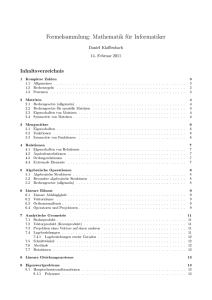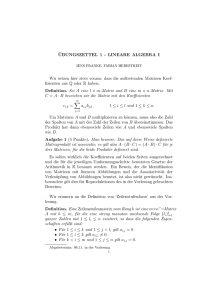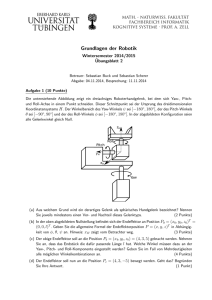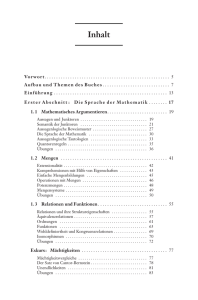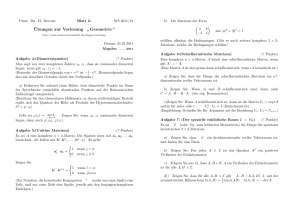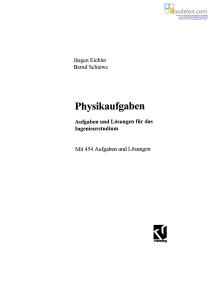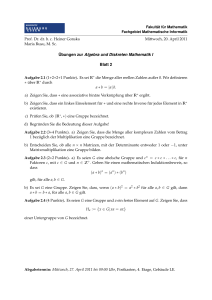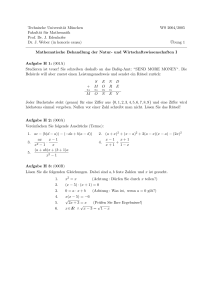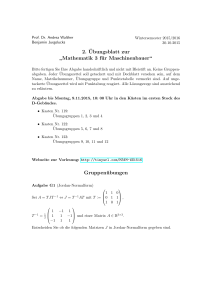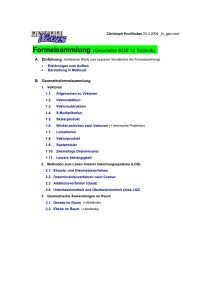Formelsammlung: Mathematik für Informatiker I
Werbung
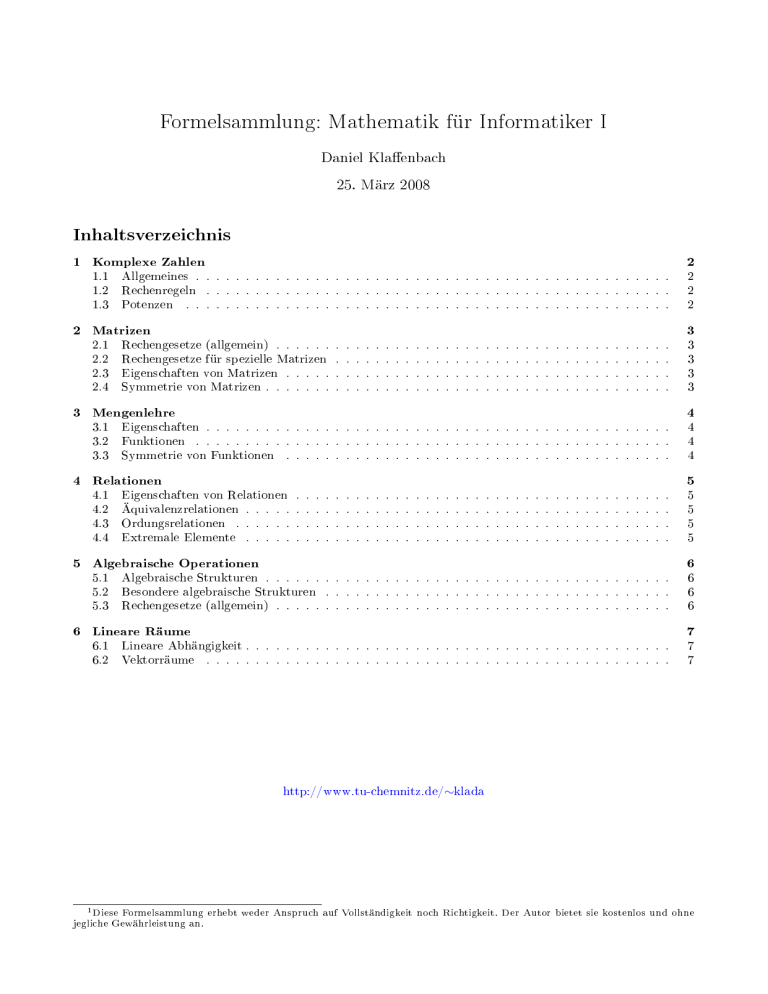
Formelsammlung: Mathematik für Informatiker I Daniel Klaenbach 25. März 2008 Inhaltsverzeichnis 1 Komplexe Zahlen 1.1 Allgemeines . . . . . . . . . . . . . . . . . . . . . . . . . . . . . . . . . . . . . . . . . . . . . . . . 1.2 Rechenregeln . . . . . . . . . . . . . . . . . . . . . . . . . . . . . . . . . . . . . . . . . . . . . . . 1.3 Potenzen . . . . . . . . . . . . . . . . . . . . . . . . . . . . . . . . . . . . . . . . . . . . . . . . . 2 2 2 2 2 Matrizen 2.1 Rechengesetze (allgemein) . . . . . . 2.2 Rechengesetze für spezielle Matrizen 2.3 Eigenschaften von Matrizen . . . . . 2.4 Symmetrie von Matrizen . . . . . . . . . . . 3 3 3 3 3 3 Mengenlehre 3.1 Eigenschaften . . . . . . . . . . . . . . . . . . . . . . . . . . . . . . . . . . . . . . . . . . . . . . . 3.2 Funktionen . . . . . . . . . . . . . . . . . . . . . . . . . . . . . . . . . . . . . . . . . . . . . . . . 3.3 Symmetrie von Funktionen . . . . . . . . . . . . . . . . . . . . . . . . . . . . . . . . . . . . . . . 4 4 4 4 4 Relationen 4.1 Eigenschaften von Relationen 4.2 Äquivalenzrelationen . . . . . 4.3 Ordungsrelationen . . . . . . 4.4 Extremale Elemente . . . . . . . . . 5 5 5 5 5 5 Algebraische Operationen 5.1 Algebraische Strukturen . . . . . . . . . . . . . . . . . . . . . . . . . . . . . . . . . . . . . . . . . 5.2 Besondere algebraische Strukturen . . . . . . . . . . . . . . . . . . . . . . . . . . . . . . . . . . . 5.3 Rechengesetze (allgemein) . . . . . . . . . . . . . . . . . . . . . . . . . . . . . . . . . . . . . . . . 6 6 6 6 6 Lineare Räume 6.1 Lineare Abhängigkeit . . . . . . . . . . . . . . . . . . . . . . . . . . . . . . . . . . . . . . . . . . . 6.2 Vektorräume . . . . . . . . . . . . . . . . . . . . . . . . . . . . . . . . . . . . . . . . . . . . . . . 7 7 7 . . . . . . . . . . . . . . . . . . . . . . . . . . . . . . . . . . . . . . . . . . . . . . . . . . . . . . . . . . . . . . . . . . . . . . . . . . . . . . . . . . . . . . . . . . . . . . . . . . . . . . . . . . . . . . . . . . . . . . . . . . . . . . . . . . . . . . . . . . . . . . . . . . . . . . . . . . . . . . . . . . . . . . . . . . . . . . . . . . . . . . . . . . . . . . . . . . . . . . . . . . . . . . . . . . . . . . . . . . . . . . . . . . . . . . . . . . . . . . . . . . . . . . . . . . . . . . . . . . . . . . . . . . . . . . . . . . . . . . . . http://www.tu-chemnitz.de/∼klada 1 Diese Formelsammlung erhebt weder Anspruch auf Vollständigkeit noch Richtigkeit. Der Autor bietet sie kostenlos und ohne jegliche Gewährleistung an. Formelsammlung: Mathematik für Informatiker I 1 Daniel Klaenbach Komplexe Zahlen 1.1 Allgemeines √ • i = −1, i2 = −1, i3 = −i, i4 = 1 • z = a + i · b, 1.2 z =a−i·b Rechenregeln • (z1 + z2 ) = z1 + z2 • (z1 z2 ) = z1 · z2 • z + z = 2a, z − z = i · 2b • z · z = a2 + b2 p √ • |z| = r = z · z = a2 + b2 1.3 Potenzen z • z −1 = 2 |z| • z 2 = (a + i · b)2 = a2 − b2 + i · 2ab • z 3 = (a + i · b)3 = a3 − 3ab2 + i · (3a2 b − b3 ) • z 4 = (a + i · b)4 = a4 − 6a2 b2 + b4 + i(4a3 b − 4ab3 ) iϕ • z n = re → n−Lösungen: √ n zk = reiϕk ϕ 2π(k − 1) ϕk = + n n 2 Formelsammlung: Mathematik für Informatiker I 2 Daniel Klaenbach Matrizen 2.1 Rechengesetze (allgemein) • A + B = B + A (kommutativ) • (A + B) + C = A + (B + C) (assoziativ) • ∃ Nullmatrix O: A + O = A • zu jeder Matrix A = (aij ) existiert eine Matrix (−A) = (−aij ) mit A + (−A) = O • (λµ) · A = λ · (µA) ∀A ∈ Km×n ∀λ, µ ∈ K • (λ + µ)A = λA + µA • λ(A + B) = λA + λB • (A · B) · C = A · (B · C) • (A + B) · C = AC + BC • C · (A + B) = CA + CB • (λA)B = λ(AB) = A(λB) • Für jede (m×n) - Matrix gibt es eine Matrix In ∈ Kn×n und Im ∈ Km×m , sodass gilt: A·In = A·Im = A. ⇒ (m × m) - bzw. (n × n) - Einheitsmatrizen 2.2 Rechengesetze für spezielle Matrizen • (AT )T = A • (A + B)T = AT + B T • (λA)T = λAT • (AB)T = B T AT 2.3 Eigenschaften von Matrizen • AT : transponierte Matrix, Spiegelung an der Hauptdiagonalen ((n × m)-Matrix wird zu (m × n)-Matrix) • A∗ = AT : transponierte Matrix; bei komplexen Zahlen wird zusätzlich das konjugiert Komplexe gebildet • A · A−1 = I = A−1 · A: inverse Matrix • hermitesch: A = A∗ (Hauptdiagonale reell (R)) • schiefhermitsch: A∗ = −A (Hauptdiagonale komplex (C)) • unitär: T · T ∗ = I = T ∗ · T 2.4 Symmetrie von Matrizen Eine (n × n)-Matrix ist • symmetrisch, wenn A = AT ⇔ aij = aji • schiefsymmetrisch, wenn AT = −A ⇔ aij = −aji • orthogonal, wenn AT · A = A · AT = I • Jede (n × n)-Matrix lässt sich als Summe A+ + A− schreiben mit A+ ist symmetrisch [hermitesch] und A− ist schiefsymmetrisch [schief hermitesch] • A+ = 1 (A + A∗ ) 2 • A− = 21 (A − A∗ ) 3 Formelsammlung: Mathematik für Informatiker I 3 Daniel Klaenbach Mengenlehre 3.1 Eigenschaften • A ∪ ∅ = A, A ∩ ∅ = ∅ A ∪ A = A, A ∩ A = A • A ∪ B = B ∪ A, A∩B =B∩A (Kommutativität) • A ∪ (B ∪ C) = (A ∪ B) ∪ C A ∩ (B ∩ C) = (A ∩ B) ∩ C (Assoziativität) • A ∪ (B ∩ C) = (A ∪ B) ∩ (A ∪ C) A ∩ (B ∪ C) = (A ∩ B) ∪ (A ∩ C) (Distributivität) • A∩B =A∪B A∪B =A∩B (De Morgansche Gesetze) • A⊂B ⇔A∩B =A∧A∪B =B • A \ (B ∪ C) = (A \ B) ∩ (A \ C) A \ (B ∩ C) = (A \ B) ∪ (A \ C) 3.2 Funktionen f : M −→ N • Surjektivität: f ist eine Abbildung von M auf N • Injektivität: f ist eine Abbildung von M in N (Allen Elementen in N wird höchstens ein Element aus M zugeordnet) • Bijektivität: f ist eine eindeutige Abbildung von M in N (Surjektivität und Injektivität zugleich) 3.3 Symmetrie von Funktionen • f1 ist eine gerade Funktion, wenn f1 (x) = f1 (−x) • f2 ist eine ungerade Funktion, wenn −f2 (x) = f2 (−x) 4 Formelsammlung: Mathematik für Informatiker I 4 Daniel Klaenbach Relationen 4.1 Eigenschaften von Relationen • R ⊂ M × M heiÿt reexiv, wenn (x, x) ∈ R ∀x ∈ M • R ⊂ M × M heiÿt symmetrisch, wenn (x, y) ∈ R ⇒ (y, x) ∈ R ∀x, y ∈ M • R ⊂ M × M heiÿt antisymmetrisch, wenn ((x, y) ∈ R ∧ (y, x) ∈ R) ⇒ x = y • R ⊂ M × M heiÿt transitiv, wenn ((x, y) ∈ R ∧ (y, z) ∈ R) ⇒ (x, z) ∈ R 4.2 ∀x, y ∈ M ∀x, y, z ∈ M Äquivalenzrelationen • Reexiv, symmetrisch und transitiv • Äquivalenzklassen: Eine Äquivalenzrelation in einer Menge M bewirkt eine Aufteilung von M in nicht- leere paarweise disjunkte Teilmengen 4.3 Ordungsrelationen • Reexiv, antisymmetrisch und transitiv 4.4 Extremale Elemente Sei (M, ≺) eine teilweise geordnete Menge und T ≺ M , dann gilt: 1. x ∈ T ist kleinstes Element in T , wenn gilt: x ≺ x ∀x ∈ T x ∈ T ist gröÿtes Element in T , wenn gilt: x x ∀x ∈ T 2. a ∈ T ist minimales Element in T , wenn für kein x ∈ T gilt: x ≺ a (x 6= a) a ∈ T ist maximales Element in T , wenn für kein x ∈ T gilt: a ≺ x (x = 6 a) 3. s ∈ M ist untere Schranke von T , wenn gilt: s ≺ x ∀x ∈ T s ∈ M ist obere Schranke von T , wenn gilt: s x ∀x ∈ T 4. g ∈ M ist gröÿte untere Schranke von T , wenn gilt: s ≺ g ∀s ∈ M g ∈ M ist kleinste obere Schranke von T, wenn gilt: g ≺ s ∀s ∈ M 5 Formelsammlung: Mathematik für Informatiker I 5 Daniel Klaenbach Algebraische Operationen 5.1 Algebraische Strukturen Die folgenden Denitionen implizieren jeweils alle ihre Voranstehenden (5. impliziert 1.-4., usw.): 1. Algebraische Struktur: [M, Ω]: die Operation Ω wird über der Menge M ausgeführt, M 6= 0 2. Gruppoid: Operation führt wieder in die Menge M : a ∗ b ∈ M ∀a, b ∈ M 3. Halbgruppe: ∗ ist assoziativ: (a ∗ b) ∗ c = a ∗ (b ∗ c) ∀a, b, c ∈ M 4. Monoid: ∃ ein neutrales Element: e = eL = eR 5. Gruppe: ∃ ein inverses Element: ∀a ∈ M ∃a−1 ∈ M mit a ∗ a−1 = a−1 ∗ a = e 6. Abelsche Gruppe: ∗ ist kommutativ: a ∗ b = b ∗ a ∀a, b ∈ M 5.2 Besondere algebraische Strukturen • Ring: [M, ⊕, ⊗] mit: [M, ⊕] ist Abelsche Gruppe [M, ⊗] ist Halbgruppe und ein Distributivgesetz gilt • Integritätsbereich: [M, ⊕, ⊗] mit: [M, ⊕] ist Abelsche Gruppe [M, ⊗] ist kommutativer Monoid frei von Nullteilern und ein Distributivgesetz gilt • Körper: [M, ⊕, ⊗] mit: [M, ⊕] ist Abelsche Gruppe [M \ θ, ⊗] ist Abelsche Gruppe, wobei θ das neutrale Element von ⊕ ist (Nullelement) und ein Distributivgesetz gilt 5.3 Rechengesetze (allgemein) • Kommutativgesetz: a + b = b + a ∀a, b ∈ M • Assoziativgesetz 1: (a + b) + c = a + (b + c) ∀a, b, c ∈ M • Assoziativgesetz 2: (a · b) · c = a · (b · c) ∀a, b, c ∈ M • Distributivgesetz 1: (a + b) · c = a · c + b · c ∀a, b, c ∈ M • Distributivgesetz 2: a · (c + b) = a · c + a · b ∀a, b, c ∈ M 6 Formelsammlung: Mathematik für Informatiker I 6 Daniel Klaenbach Lineare Räume 6.1 Lineare Abhängigkeit x1 x2 xn → → yn • − a1 = y1 , − a2 = y2 , ... , − a→ n = z1 z2 zn • n-Vektoren heiÿen linear abhängig, wenn einer der Vektoren Linearkombination der anderen ist → − → → • λ1 · − a1 + λ2 · − a2 + ... + λn · − a→ n = 0 → linear unabhängig, wenn nur die triviale Lösung existiert (λ1 = λ2 = ... = λn = 0), sonst linear abhängig 6.2 Vektorräume • Vektorraum: [M, ⊕, ⊗] mit: [M, ⊕] ist Abelsche Gruppe [M, ⊗] ist Körper: ∗ ∗ ∗ ∗ ∗ α · x ∈ M ∀α ∈ K, ∀x ∈ M α · (x + y) = αx + αy (α + β)x = αx + βx ∀α, β ∈ K, ∀x, y ∈ M (α · β) · x = α · (β · x) ∃ Einselement: 1 · x = x 7
